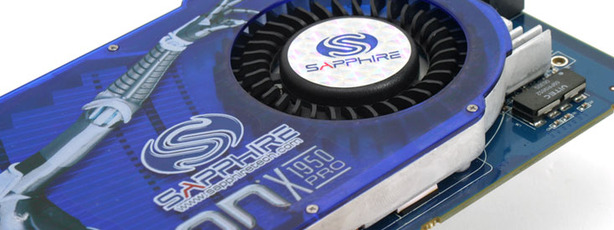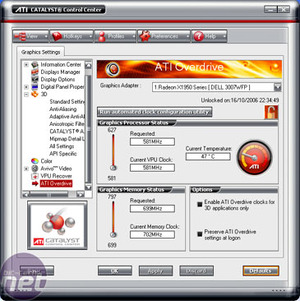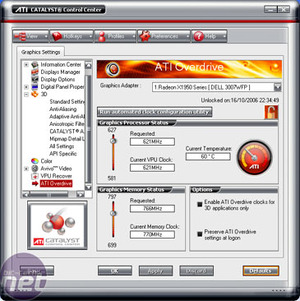Overclocking:
We overclocked the Sapphire Radeon X1950 Pro using ATI’s Overdrive utility that is built into the Catalyst Control Center. It’s certainly not the best overclocking tool out there, but it should be sufficient to give you an idea how far Radeon X1950 Pro should overclock. As always though, overclocking mileage may vary in your own experiences and we cannot guarantee that this Radeon X1950 Pro isn’t a particularly good overclocker.The default frequencies for the card are 580MHz on the core, and 1400MHz on the memory. As we mentioned earlier in the review, the card comes with 1.2ns DRAM chips, so there should be some room for overclocking on that front.
When we overclocked the card, we managed to get the core running stably at 621MHz and the memory was artifact free at 1540MHz. The Overdrive utility said that higher memory frequencies were stable, but we encountered artifacting problems in both Oblivion and Half-Life 2: Episode One and we had to back down in order to prevent the artifacting.
With the higher frequencies, we noticed quite a large increase in core temperature at both idle and load. In turn this also led to the fan speed increasing, but it wasn’t annoyingly loud at the frequencies we managed to get the card running stable at. This tells us that there is probably more room for overclocking with a better cooling solution, so it might be wise to look at something like a Zalman VF900-series cooler or one of Arctic Cooling’s Accelero aftermarket solutions.

Final Thoughts...
With the exception of Quake 4, we have been really impressed with the performance of Sapphire’s Radeon X1950 Pro. The fact that it is able to outclass one of the fastest factory-overclocked GeForce 7900 GS’s out there in Oblivion, and keep pace in Battlefield 2 speaks volumes for how good we think this card is. Catalyst 6.9 appears to improve the situation in Quake 4 somewhat though, as we’re no longer encountering the stuttering problems that have plagued us in the past.Providing Sapphire can meet its aggressive pricing forecasts – an expected retail price of around £135 including VAT – I think it has a winner here. With BFG Tech’s GeForce 7900 GS OC costing around £145 including VAT, it’s left in a tricky position, especially when Sapphire’s Radeon X1950 Pro trumps it on performance and features. Much like ATI’s Radeon X1900XT 256MB, the performance that this card delivers in DirectX 9 titles is on another level to anything else out there. If it wasn’t for the relatively poor OpenGL performance, it would be one of the best all round mid-range video cards we’ve seen for some time.
Those of you who play OpenGL games might find NVIDIA’s GeForce 7900 GS to be a better prospect, and from our experiences, GeForce 7900 GS presents more opportunities for overclocking – even with the puny reference cooler. If you’re looking to get a lot of headroom out of a Radeon X1950 Pro, you’re probably going to need an aftermarket cooling solution – that’s going to set you back even more.
We said that Leadtek’s PX7900 GS TDH was probably the best GeForce 7900 GS out there, because it overclocked as well as the other cards along with being HDCP ready and having a very aggressive price point. However, if we were just taking stock performance into account, the additional £10 spent on the Radeon X1950 Pro is going to give you a lot more performance for your money – performance that’s worth paying for in our opinion.
While GeForce 7900 GS is still a great card with a fantastic price point, it seems that ATI has revealed its hand and has come up trumps with four aces. The only way that GeForce 7900 GS is going to compete with Radeon X1950 Pro is for it to receive a price reduction. It’ll be interesting to see how NVIDIA reacts to ATI’s new performance-mainstream star.

Sapphire Radeon X1950 Pro 256MB

MSI MPG Velox 100R Chassis Review
October 14 2021 | 15:04











Want to comment? Please log in.